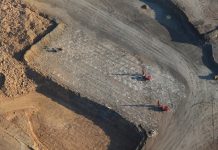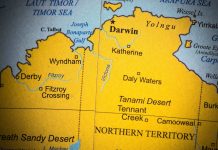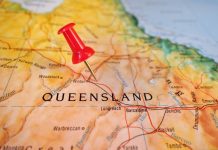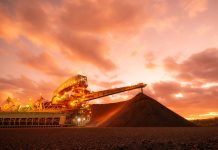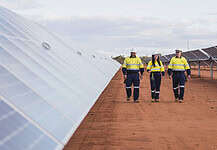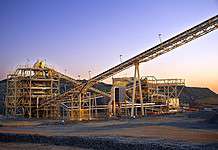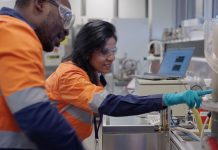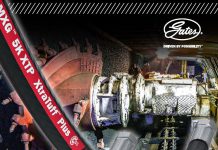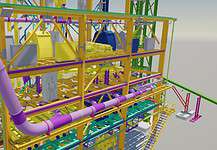SINCE its establishment in 1989, Centennial Coal has grown to become Australia’s largest independent coal company, supplying thermal and coking coal to domestic and export markets.
A subsidiary of Banpu Public Company, Asia’s largest independent coal group, Centennial is one of the largest underground coal producers in NSW.
It is a major supplier to the state’s energy industry, fuelling about 46 per cent of NSW’s coal-fired electricity from 12 mines: Springvale, Angus Place, Lamberts Gully, Charbon, Ivanhoe North, Clarence, Mandalong, Awaba, Newstan, Myuna, Mannering and Airly.
Springvale and Angus Place The Springvale colliery is managed by Springvale Coal on behalf of its owners: joint venture (JV) partners Centennial Springvale (a Centennial Coal subsidiary) and Springvale SK Kores. Underground longwall mining began at Springvale in 1995. On March 15, 2012 Centennial received approval from Federal Environment minister Tony Burke for a proposed extension to its Springvale longwall coal mine. The extension of the mine, 15km northwest of the city of Lithgow, will see the operation expanded to mine three longwall panels in an area covering 330 hectares.
The announcement of the approval was welcomed by Lithgow mayor Neville Castle, who said that the city would have suffered if the approval was not granted. “Coal mining and…power generation…probably takes up more than 50 per cent of our economy, or probably closer to 70 per cent of our economy,” he told the ABC. “So we have also all the other businesses that somehow are affected by that in flow on effects…so we’re glad to see it keep going.” In granting the approval, Mr Burke stated that he had considered the social and economic implications of the project, but his focus had been on protecting environmental matters of national significance “through strict conditions to manage any potential environmental impacts”.
“In making this decision, I took into consideration advice on monitoring and management arrangements from the new Interim Independent Expert Scientific Committee on Coal Seam Gas and Coal Mining,” he said. The Springvale mine extension approval is subject to 30 strict conditions placed on the mine’s activities to ensure the environmental protection of the surrounding area. One condition includes the detection of any potential impacts of the mine for a period of at least 10 years post-mining. The Angus Place colliery lies adjacent to Springvale, and mining began at the underground longwall operation in 1979. In December 2006, Centennial announced that it had reached an in-principle agreement
to sell 50 per cent of its interest in Angus Place to its existing Springvale JV partners. “These arrangements will create further opportunities to maximise synergies between Springvale and Angus Place, with enhanced sharing of infrastructure, technical services and other resources, which should result in greater production efficiency and marketing optimisation – including increased opportunity to participate in export market opportunities,” Centennial reported at the time.
The JV sale arrangements were finalised in June 2007. Springvale and Angus Place have a combined nominal annual production capacity of more than 7 million tonnes per annum of thermal coal, which is supplied to both domestic and export customers.
Domestic contracts with Wallerawang and Mount Piper power stations total 5.1mtpa, and dedicated conveyors and haul roads were constructed for delivery of the coal to these facilities. Coal is also transported via Lidsdale Siding to Port Kembla, near Wollongong, for export.
The Lamberts Gully open cut coal mine lies adjacent to the Springvale coal preparation plant and Delta Electricity’s two western power stations at Blackmans Flat near Lithgow. Springvale Coal owns and operates the mine, which is a truck and shovel operation producing coal for both export and domestic customers. In 2006, Springvale Coal applied for, and was granted, approval to extend the Lamberts Gully open cut within the mine’s existing lease areas.
According to the application, the expansion included the extraction of an additional 1.5mt of coal across an eight-year period, at a maximum annual production rate of 400,000t.
Centennial Coal owns 95 per cent of the Charbon colliery JV, with SK Australia holding the remaining 5 per cent. Near Kandos in NSW’s Western Coalfield, Charbon comprises underground continuous miner and open cut mining operations, a modern rail loading facility and a coal preparation plant. It produces about 1.3mtpa of coal for export, which is transported by rail to the Port Kembla coal loader, plus a small amount that is sold to domestic customers and trucked by road.
The Charbon mining area has additional resource opportunities that Centennial is reportedly exploring for possible expansion. Ivanhoe North In May 2007, Centennial Coal received approval to proceed with the Ivanhoe North Rehabilitation Project: an initiative to rehabilitate a previously mined area on the Ivanhoe colliery holding near Mount Piper Power Station, in Central West NSW. When the project was approved, Centennial Coal outlined that it would involve: extraction of 550,000t of coal across two years, using a truck and shovel mining method; on-site crushing of up to 300,000t of coal per year; construction of a site entrance off Castlereagh Highway and upgrading of an existing site access road; construction of an internal road for hauling coal; installation of a range of services structures and temporary buildings; and progressive rehabilitation of the site. The company reported that coal would be transported via the Castlereagh Highway to Mount Piper and Wallerawang power stations, Western Main Colliery and Lidsdale Siding.
Centennial also reported that Ivanhoe North would produce thermal coal for export, to be shipped through the Port Kembla coal loader, and that it would have the ability to deliver coal to domestic markets if required.
The Clarence colliery, 10km from Lithgow at Newnes Junction on the Newnes Plateau, has been in production since 1979. The operation is owned by the Clarence JV: an unincorporated joint venture between Coalex, Clarence Coal Investments,
Japan Energy Australia and SK Australia. It is managed by Clarence Colliery. Clarence has resources of about 230mt and estimated marketable reserves of 48mt. The underground operation mines the Katoomba Seam, the uppermost seam in the Illawarra Coal Measures, using partial pillar extraction system technologies. It primarily produces low-sulphur thermal coal for sale and export to markets in Korea, Taiwan and Japan, with a small amount retained for the domestic market.
Mandalong Centennial’s Mandalong mine lies near Morisset in the Newcastle Coalfield. Longwall mining began at Mandalong in January 2005, utilising a high-capacity Joy longwall unit mining up to 5mtpa of coal, and continuous miner development.
The longwall unit incorporates two shearers and other duplicate equipment to reduce longwall changeover times, and mines a longwall block width of 150m. Centennial has estimated that Mandalong has recoverable reserves of about 102mt, and the company has enjoyed high production levels from the mine: production peaked at 5.5mt in 2010, and has averaged about 5mtpa thereafter, with production levels dependent on longwall changeovers (there are an average of
three longwall changeovers every 24 months).
Centennial holds long-term offtake contracts with local power generators for production from Mandalong, and coal is delivered to these customers via dedicated conveyors. In 2011, Centennial also targeted exports of about 1.5mt from the operation, with export sales from the mine expected to increase in the future. Centennial has reported that it plans to extend Mandalong. Awaba, Newstan and the Newstan Lochiel expansion In November 2011, Centennial announced that it would close its Awaba underground coal mine at the end of the following month. The miner had always anticipated that the mine would be closed by late 2011, when its reserves were forecast to be exhausted. Awaba, near Toronto in the Newcastle Coalfield, was originally owned by the NSW State Government and began operations in 1948, producing export-quality, low-sulphur, medium-ash thermal coal.
Centennial purchased the mine in 2002, and broadened its scope of operations to include exports as well as servicing the Erering Power Station.
In 2010 the mine produced more than 800,000t of coal, but with reserves exhausted in the immediate mining area, Centennial reported that it had made the decision to close the mine.
The operation had always been relatively small, with less than 100 workers on site. Awaba employee Ross Smith told local newspaper The Newcastle Herald that the operation had been winding down for some time, prior to Centennial’s confirmation of the mine’s closure.
“It had closed down for a while and was then reopened, and we’ve been going back doing pillar extraction – getting the last bits of coal out of areas that were, in some cases, mined many years ago,” Mr Smith said. “It’s good quality coal: in fact, we’ve been exporting some of it recently. But that’s the end of it here in the Great Northern Seam.” Mr Smith said at the time that Awaba’s miners would work their last shift on December 23, 2011. A spokesperson for Centennial said that pit top infrastructure from Awaba would be used to support the company’s proposed Newstan Lochiel project, an expansion of its existing Newstan mine.
According to the Newstan Lochiel development plan, Centennial would extract up to 5mtpa of coal for 21 years, and continue to receive and handle run of mine coal from Awaba and Mandalong at the Newstan Colliery’s surface facilities area.
The company would aim to transport up to 8mtpa by rail from the Newstan colliery to Newcastle and Port Kembla for export. According to a preliminary report by Centennial, if the development was to go ahead, Newstan’s coal preparation plant and washery would process up to 8mtpa of coal from Newstan, Awaba and Mandalong: double the amount the company is permitted to process at the plant now.
Myuna, at Wangi Wangi on Lake Macquarie in the Newcastle Coalfields, has resources of more than 380mt of low-sulphur thermal coal suitable for both export and domestic markets.
The operation includes underground mining of three seams using continuous miners. Myuna lies in close proximity to its major customer Eraring Energy, and a dedicated conveyor delivers coal directly to Eraring.
In January, Centennial was granted approval to expand the Myuna mine as part of a plan to significantly boost overall production from its mines in the Lake Macquarie area. The approval will allow Myuna to continue operating for another 21 years and will see production at the mine increase to 2mtpa.
Mannering Colliery lies in the Newcastle Coalfield, and mining focusses on the Fassifern Seam. Mannering has a production capacity of more than 1mtpa and resources exceeding 250mt.
The mine is close to its major customer Delta Electricity, and supplies coal to Delta via a dedicated conveyor.
Mannering was on the edge of closure in 2008, but improved mining methods and market demand encouraged Centennial to re-think the mine’s future.
Now, plans to extend underground mining at Mannering may see up to an extra 256 hectares of land used for coal extraction and an additional 4.5mt extracted from the mine each year.
In August 2008, the Centennial board granted approval for the development of the Airly mine: an operation with a production capacity of between 1.6mtpa and 1.8mtpa of export-quality coal.
The project had an estimated start-up capital cost of $104 million and production began at the mine, north of Lithgow, in December 2010. Airly has large, high-quality reserves sufficient to support mining for more than 20 years, with resources of about 120mt.
Mining methods in use at the mine include a combination of place-changing, super panel, super place-changing and partial extraction continuous miner techniques. Coal is exported via rail to the Port Kembla coal loader.

